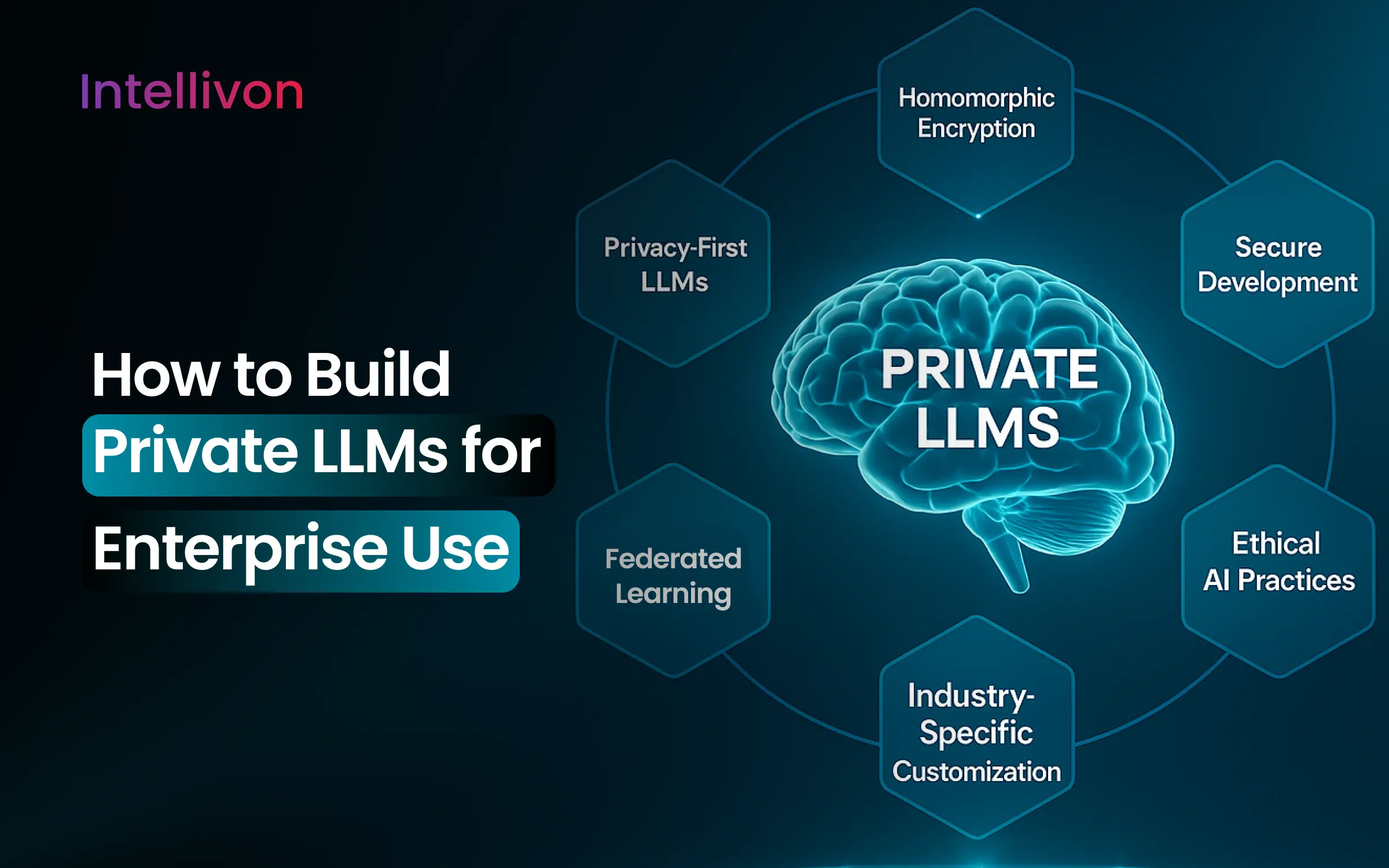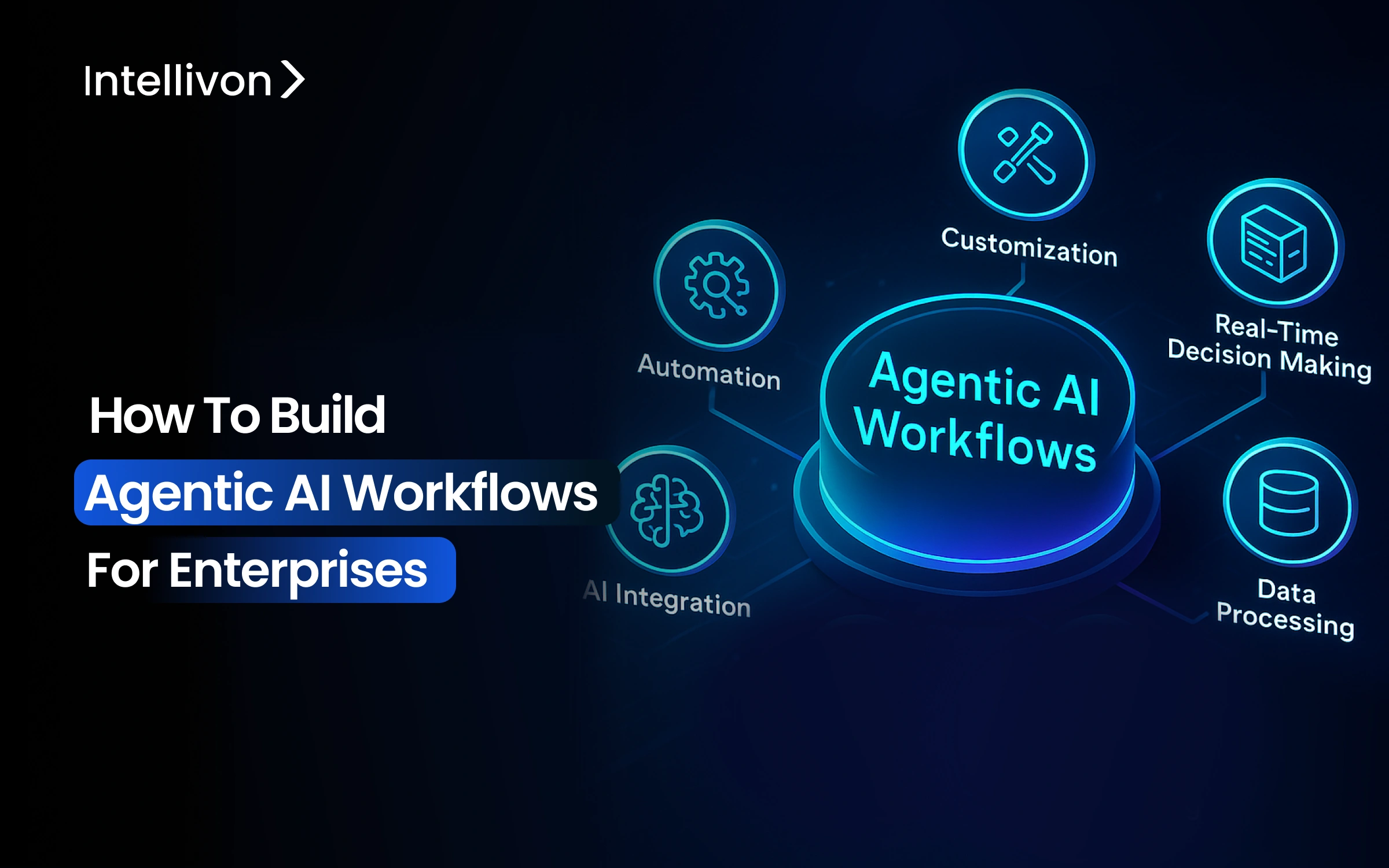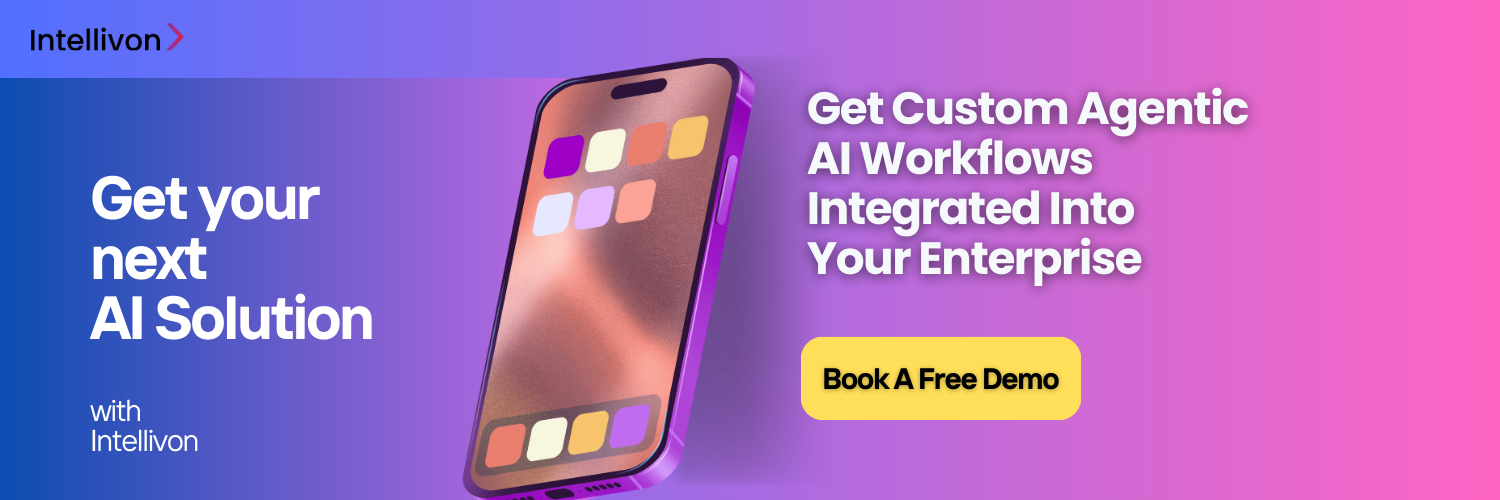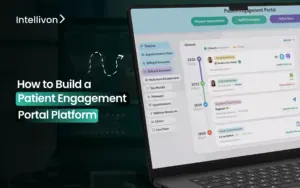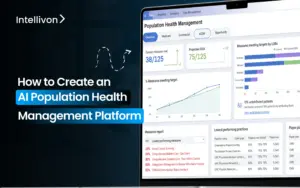In the current AI-dominated landscape, traditional AI systems still struggle with the dynamic decision-making required to stay competitive. Enterprises with vast proprietary data and complex, intricate workflows need systems that can automate processes, and at the same time think, learn, and adapt on their own. That’s where agentic AI workflows come in. These intelligent systems transform your business by handling complex, end-to-end processes with remarkable autonomy and precision. Enterprises that have adopted agentic AI workflows will be able to tackle new situations, learn from data, and make decisions with far more speed and accuracy. PayPal uses agentic AI in its workflows and, as a result, has automated 90% of individual automobile claims in large-scale insurance use cases.
We have helped large enterprises successfully integrate agentic AI workflows into their operations, streamlining repetitive tasks and handling complex issues. This has helped their teams focus on strategic work while the AI agents that we built took care of the grunt work. In this blog, we will show you how we built these systems and tailored them to enterprise-specific requirements, driving efficient workflows and higher ROIs.
Key Insights of the Enterprise AI Agent Market
The global enterprise agentic AI market was valued at USD 2.58 billion in 2024 and is projected to grow to USD 24.50 billion by 2030, with a CAGR of 46.2% from 2025 to 2030, according to a Grand View Research report. Key drivers of this growth include the increasing complexity of business environments and the need for faster decision-making.
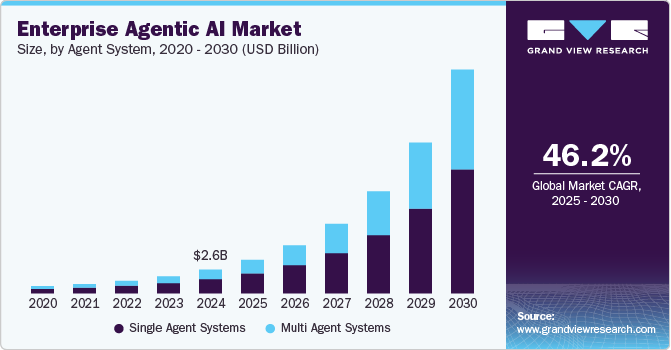
Credit: Grand View Research
Key Market Trends & Insights:
- North America led the global enterprise agentic AI market in 2024, accounting for over 39% of the market share.
- The U.S. is expected to show significant growth in the agentic AI market over the forecast period.
- Machine learning was the leading technology segment in 2024, holding 29% of the global market revenue share.
- The single-agent systems segment dominated in 2024 due to their simplicity and cost-effectiveness in automating specific tasks.
- By 2025, it’s expected that over 60% of repetitive workflows in major enterprises will be managed by AI agents.
Why Enterprises Need Agentic AI Now
In today’s fast-paced business world, enterprises face growing pressure to stay competitive, drive innovation, and reduce costs. Traditional methods of automation are no longer enough to meet these demands. This is where agentic AI comes into play, offering a new level of autonomy and precision in managing workflows.

1. Increased Complexity in Operations
Business environments are more complex than ever. Companies juggle multiple tasks, data sources, and customer expectations, all while trying to make quick, informed decisions. Agentic AI steps in to automate these complex processes. Unlike traditional automation, which follows rigid rules, agentic AI can adapt to new information, learn from experience, and make decisions on its own.
Take IBM Watson Health as an example. In healthcare, the AI system processes and analyzes vast amounts of medical data to recommend personalized treatment plans for patients. This reduces the time doctors spend on administrative tasks, allowing them to focus more on patient care. The ability of AI to make intelligent decisions and adapt to new data makes it an invaluable tool for businesses dealing with increasing complexity.
2. Speedy Decision-Making
In industries like finance, healthcare, and logistics, even a small delay in decision-making can have significant consequences. In supply chain management, for instance, AI agents can predict disruptions before they happen and take action. Gartner reports that companies using AI-powered supply chains experience 50% faster decision-making and 30% cost reduction. This efficiency would be impossible with traditional, manual workflows.
Similarly, in retail, companies like Walmart and Amazon are using AI to optimize their inventory management. AI systems predict demand patterns, manage stock levels, and even reorder products automatically. This not only reduces waste but also ensures that customers always find the products they need when they need them. AI-driven decision-making allows these businesses to move quickly, responding to demand fluctuations without human intervention.
3. Scalability and Adaptability
As enterprises grow, their processes must scale seamlessly. Agentic AI allows businesses to automate more tasks without the need for a proportional increase in human resources. This scalability is especially evident in customer service. AI-powered systems, such as chatbots and virtual assistants, can handle thousands of customer inquiries simultaneously, providing 24/7 support. This scalability helps businesses meet rising demand without compromising quality.
4. Future-Proof Solution
The evolution of AI technology means that agentic AI workflows will only become more sophisticated. They’ll be capable of handling increasingly complex decision-making and automating entire enterprise processes. By embracing agentic AI now, businesses can optimize their operations today while future-proofing themselves for tomorrow’s challenges. The ability to adapt, scale, and make decisions faster than ever will be a defining feature of successful enterprises in the years to come.
How Agentic AI Works in Enterprise Workflows
Agentic AI workflows are much more than simple automations. Imagine an employee who not only follows instructions but also understands the bigger picture, makes smart decisions, and improves over time. That’s how agentic AI works. It’s a system that learns and adapts, making it incredibly valuable for enterprises that want to move beyond basic task automation. Here’s a breakdown of how it works:
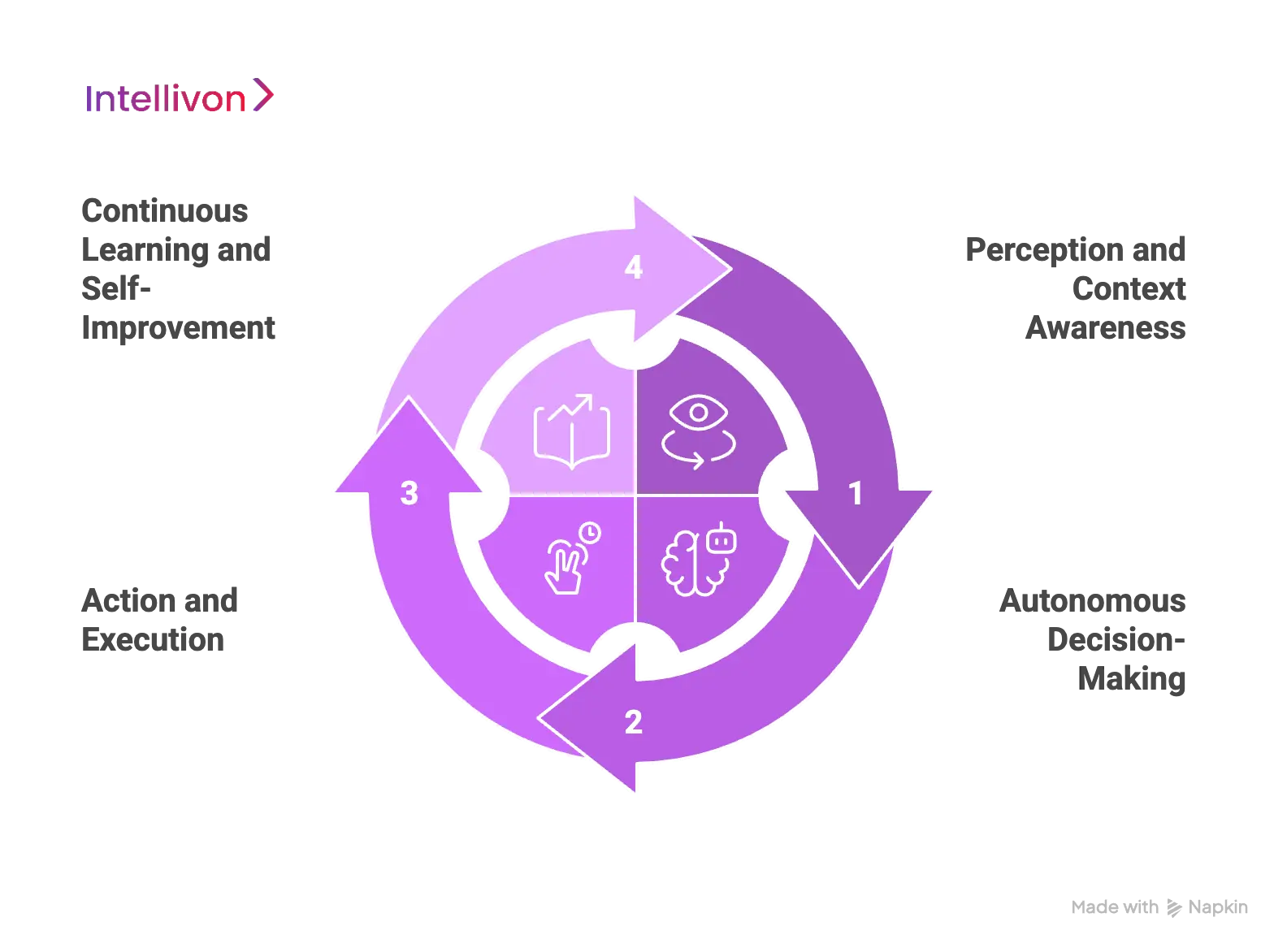
1. Perception and Context Awareness
The first step in an agentic AI workflow is “perception.” This means the system collects and processes data from multiple sources. Think of it like a customer service bot reading customer emails, a supply chain agent monitoring inventory levels, or a financial agent tracking market trends.
But the AI understands the context after collecting the data. For example, it knows whether its goal is to resolve customer issues quickly or optimize inventory costs. By understanding the goal, the AI prioritizes the data it collects and makes sense of it in a way that’s relevant to the task at hand.
2. Autonomous Decision-Making
This is where agentic AI truly shines. Based on the data it perceives and the context it understands, the AI autonomously decides on the best course of action.
For instance, a customer service AI might decide to send a knowledge base article for a simple query. However, if it recognizes the issue as more complex, it might escalate the case to a human expert.
What’s key here is that the AI doesn’t rely on pre-programmed responses for every scenario. It uses its models to assess the situation, just like a human employee would, and then chooses the most effective solution. This autonomy in decision-making allows the AI to respond flexibly and efficiently.
3. Action and Execution
Once the decision is made, the agentic AI workflow takes action. This could be something as simple as sending an email or as complex as rerouting a global supply chain.
The AI seamlessly integrates with existing enterprise tools, like CRM systems, ERP platforms, or business applications. This means it can execute tasks directly within the company’s existing infrastructure. Whether it’s managing inventory, processing orders, or updating customer records, the AI workflow executes actions as part of the regular business operations.
4. Continuous Learning and Self-Improvement
What makes agentic AI even more powerful is its ability to learn from its actions. Unlike traditional automation that requires a developer to make updates, agentic AI continuously refines its decision-making process.
The system monitors the results of its actions: Was the customer satisfied? Did the inventory change save costs? It uses this feedback to improve its models and decisions over time.
This self-improvement loop means that the AI workflow not only gets better with experience but also adapts to new challenges. It evolves with the business, becoming smarter and more effective, without needing constant human intervention.
The result is a dynamic system that does more than automate tasks. It evolves, improves, and adapts, making it an essential tool for businesses aiming for growth and efficiency.
Benefits of Agentic AI for Enterprise Workflows
Agentic AI represents a fundamental shift in how enterprises operate. It’s the difference between a tool that simply follows a script and a system that can think, adapt, and make decisions on its own. For enterprises, this transformation brings a range of powerful benefits that go far beyond simple efficiency.
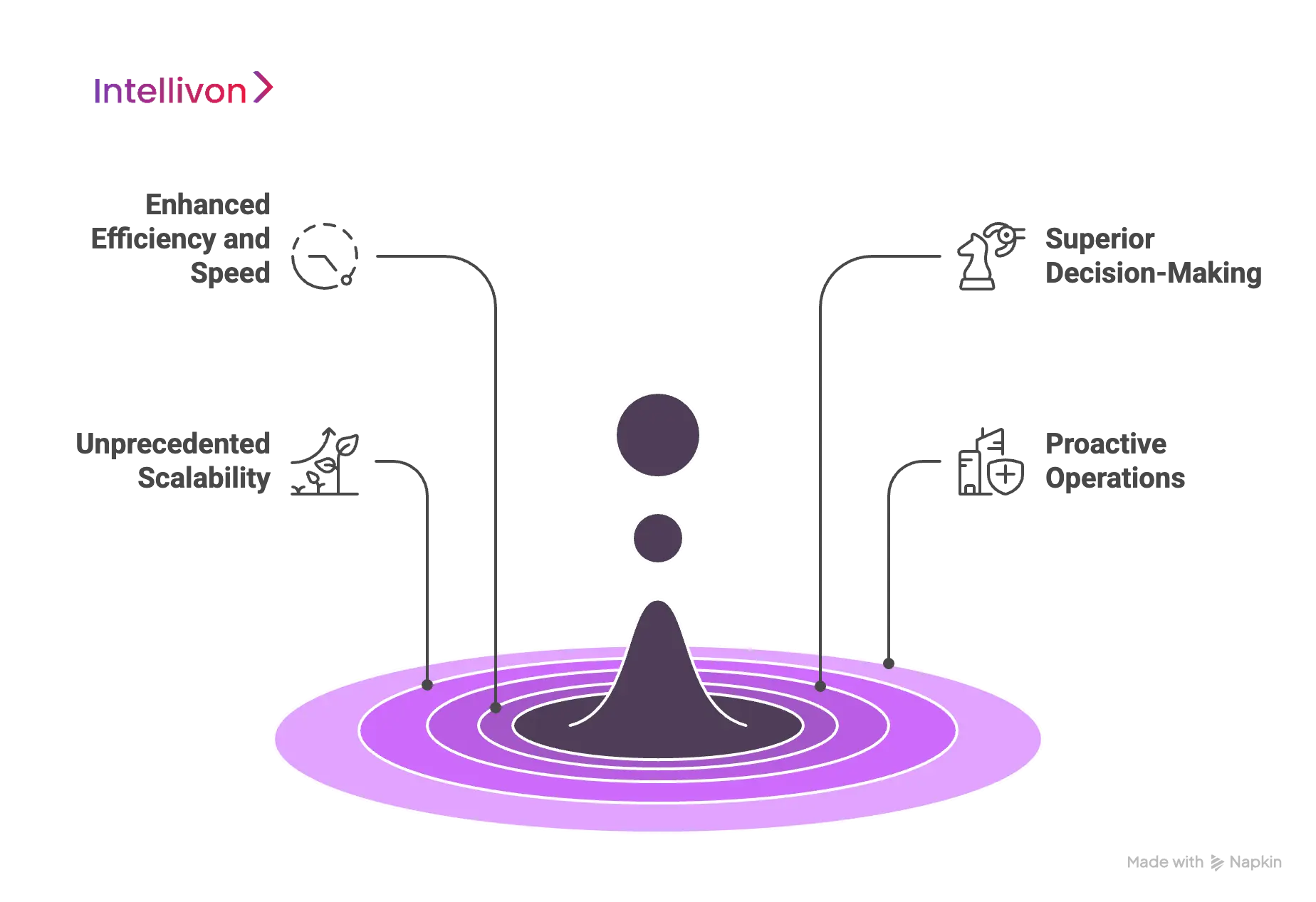
1. Enhanced Efficiency and Speed
Traditional automation can handle repetitive tasks, but it often struggles when a process doesn’t go as planned. This is where agentic AI steps in. Unlike basic automation, agentic AI can autonomously manage complex workflows, making real-time decisions and rerouting tasks without needing human intervention.
This ability to think on its own eliminates bottlenecks and accelerates operations across the entire organization. Whether it’s processing customer requests, managing inventory, or optimizing supply chains, agentic AI speeds things up significantly.
As a result, businesses can do more with the same resources, but faster and with far less effort. This newfound efficiency gives enterprises the ability to scale quickly without adding extra overhead or hiring more staff.
2. Superior Decision-Making
Agentic AI is about making smart, data-driven decisions. These systems can process vast amounts of data in real time, identify key patterns, and predict future outcomes with incredible accuracy.
For example, in areas like fraud detection, agentic AI can analyze transactions in milliseconds and flag suspicious activity instantly, something that would be nearly impossible for humans to do at the same speed or level of accuracy.
In industries like finance, where quick decision-making is essential, agentic AI empowers businesses to make better, more strategic choices. The result? Fewer errors, smarter decisions, and more confident business operations.
3. Unprecedented Scalability
As your business grows, so do your challenges. Manual processes become difficult to sustain, and hiring more employees to keep up with demand often leads to high costs and slowdowns. But with agentic AI, scaling becomes effortless.
Agentic AI workflows can handle massive increases in volume without requiring a proportional increase in resources. Whether you’re dealing with more customer queries, larger inventory, or expanding operations, AI systems can scale seamlessly. This gives businesses the flexibility to adapt to market changes, expand into new regions, and launch new products with agility and confidence. The ability to grow without the typical growing pains makes agentic AI an essential tool for enterprises aiming for long-term success.
4. Proactive Operations
One of the most significant advantages of agentic AI is its ability to anticipate rather than simply react. Traditional systems often wait for problems to arise before taking action. But agentic AI goes a step further; it proactively identifies potential issues before they even happen.
For instance, a predictive maintenance agent monitors equipment and can schedule repairs before a breakdown occurs, avoiding costly downtime. Similarly, in customer service, AI can detect early signs of dissatisfaction and reach out to resolve the issue before the customer even realizes there’s a problem. This proactive approach reduces costs, prevents future problems, and improves customer satisfaction.
With agentic AI, businesses can move faster, make better decisions, scale effortlessly, and stay ahead of potential issues. These benefits not only streamline operations but also give enterprises a competitive edge in a rapidly changing market.
Real-World Use Cases of Agentic AI Workflows for Enterprises
Agentic AI workflows are already transforming industries that rely on complex data, real-time decision-making, and multi-step processes. These systems go beyond basic automation by creating intelligent workflows that can learn, adapt, and optimize operations on their own. Here are some real-world examples across key industries:
1. Finance and Banking
The financial sector deals with large volumes of data and demands constant attention to risk and compliance. Agentic AI is a game-changer here.
- Fraud Detection and Prevention: Agentic AI monitors millions of transactions in real time. If it spots an unusual spending pattern, the AI immediately flags it, puts a security hold on the transaction, and notifies the customer, all within seconds. This prevents fraud before it happens.
- Dynamic Credit Risk Assessment: Instead of using just static credit scores, agentic AI analyzes real-time financial data, market trends, and even customer behavior. It gives a more accurate and up-to-date risk assessment for loans and can suggest different products or adjust interest rates automatically.
- Personalized Wealth Management: AI can act as a personal financial advisor, rebalancing investment portfolios based on market changes or client preferences. It ensures the client’s goals are always in focus.
Real-World Example: JPMorgan Chase uses AI agents to handle tasks like loan processing and fraud detection. These systems not only identify fraud but also learn from each case, improving their ability to spot new threats.
2. Healthcare and Pharmaceuticals
Agentic AI in healthcare can enhance patient care, reduce administrative burdens, and speed up processes like drug discovery.
- Autonomous Patient Monitoring: AI agents can monitor patient data from electronic health records, wearables, and lab results. If a patient’s vitals change, the AI alerts the medical team, schedules follow-ups, or adjusts treatment plans automatically.
- Clinical Trial Automation: AI agents can identify patients who are ideal candidates for clinical trials, manage schedules, and analyze results in real time. This helps researchers speed up trials and reduce administrative tasks.
- Predictive Diagnostics: By analyzing data from medical imaging, lab results, and patient history, AI can identify patterns and flag potential diseases before they’re noticed by doctors, speeding up diagnosis and treatment.
Real-World Example: GSK uses AI to speed up drug discovery. The AI examines molecular data, predicts which compounds may be effective, and helps researchers identify promising drug candidates faster and cheaper.
3. Supply Chain and Logistics
The complexity of supply chains benefits greatly from agentic AI’s ability to handle real-time data and make fast decisions.
- Intelligent Inventory Management: AI agents monitor stock levels, sales trends, and external factors like weather or market news. They automatically place orders and adjust inventory to prevent stockouts or overstocking.
- Dynamic Route Optimization: AI workflows analyze traffic, weather, and delivery schedules to suggest the fastest routes for delivery trucks. It even updates drivers’ GPS systems and notifies customers about new delivery times.
- Proactive Risk Management: AI can predict disruptions by monitoring global news, supplier performance, and weather. It can recommend solutions, like switching suppliers or rerouting shipments, before any issues arise.
Real-World Example: Walmart uses AI to assist its supply chain teams in quickly identifying and fixing inventory problems. The AI actively investigates issues and provides real-time, actionable solutions.
4. Retail and E-commerce
Agentic AI enhances both customer experiences and backend operations in retail and e-commerce.
- Personalized Customer Engagement: AI can act as a personal shopping assistant, offering tailored product recommendations based on a customer’s browsing history and preferences. It can even create custom seasonal collections for individual customers.
- Dynamic Pricing and Promotions: AI agents monitor competitor prices and demand levels. They automatically adjust prices, launch promotions, or offer discounts to boost sales, optimizing profits in real time.
- Automated Returns and Refunds: AI workflows can manage the entire returns process, validating orders, generating return labels, and processing refunds once items are received, cutting down customer service time and improving the customer experience.
Real-World Example: Stitch Fix uses AI to personalize clothing recommendations for customers. Agentic AI could enhance this by automatically analyzing customer feedback and new trends to update product offerings, placing orders for new inventory based on predicted demand.
5. Energy and Utilities
With complex infrastructure, the energy sector benefits greatly from AI’s ability to predict and manage operations in real-time.
- Predictive Maintenance: AI systems monitor data from power plants and equipment. They predict failures before they happen, scheduling maintenance or repairs to avoid costly outages.
- Grid Management and Optimization: AI can balance energy loads across various sources, such as solar, wind, and traditional power plants, ensuring grid stability and efficiency.
- Autonomous Resource Allocation: AI agents forecast energy demand based on weather, time of day, and historical usage. They automatically adjust energy output to match demand, improving efficiency and reducing waste.
Real-World Example: Siemens is using AI to optimize power grid operations. Their AI systems create digital models of grids and make real-time decisions to keep everything running smoothly, improving efficiency and resilience.
6. Telecommunications
Telecom companies handle large networks and a high volume of customer interactions, making agentic AI a valuable tool.
- Autonomous Network Optimization: AI agents monitor network performance in real time. If they detect a problem, such as a slow connection or potential outage, they can automatically re-route traffic, fix the issue, and notify the team.
- Proactive Customer Issue Resolution: Instead of waiting for complaints, AI can detect network issues (e.g., slow internet in a neighborhood) and proactively notify affected customers with an estimated resolution time.
- Automated Billing Audits: AI can automatically review billing data to detect errors. It generates reports, recommends adjustments, and processes refunds, ensuring customers are billed accurately.
Real-World Example: Telefonica uses AI to manage its network infrastructure. With agentic AI, the network could be self-healing, detecting and resolving issues without human input.
7. Manufacturing
Agentic AI can streamline production lines, improve quality control, and enhance maintenance in manufacturing.
- Autonomous Quality Control: AI uses computer vision to inspect products on the production line, automatically detecting defects and removing faulty items. It can even adjust the machinery to prevent further errors.
- Predictive Maintenance: Just like in energy, AI monitors manufacturing equipment for signs of failure. It schedules repairs and orders parts before any issues cause downtime.
- Intelligent Production Planning: AI can analyze demand forecasts, inventory levels, and production schedules to optimize workflows. It ensures the right products are made at the right time, minimizing waste and maximizing output.
Real-World Example: Bosch uses AI to optimize production in their factories. With agentic AI, these systems could become even more autonomous, diagnosing problems and adjusting production without human input.
Agentic AI is already making a significant impact across industries, enhancing efficiency, decision-making, and scalability. With its ability to learn, adapt, and improve, it transforms how businesses operate at every level.
Key Components We Use While Building Agentic AI Workflows
Building an agentic AI workflow is like constructing a complex machine. Each part must work together seamlessly. At Intellivon, we focus on four core components to create intelligent, autonomous systems that drive real business value. These components are designed to be technically sound, easy to integrate, and perfectly aligned with your business goals.
1. Data Integration
Every agentic AI workflow relies on a steady, high-quality flow of data to make smart decisions. We see data as the lifeblood of the system.
1. The Power of Quality Data
The success of any AI workflow depends on the quality of its data. If the data is flawed, the AI’s decisions will be too. That’s why we focus on ensuring that the data is clean, accurate, and relevant.
2. Assessing and Preparing Data
Before building the AI system, we help you assess your existing data. This means identifying what data you already have, where it lives (CRM systems, spreadsheets, IoT sensors, etc.), and its current state. We then clean and normalize this data to ensure it is ready for AI use.
3. Leveraging Cloud and Big Data Systems
To manage large data volumes, we rely on robust cloud-based platforms like AWS and Azure. These platforms provide the scalable infrastructure needed to store, process, and manage massive amounts of data, enabling real-time operation for your AI workflows.
2. Autonomous Decision-Making Models
The decision-making model is the “brain” of agentic AI. It’s what allows the system to think and act independently.
1. AI Models Explained Simply
We use a variety of proven AI models, each suited for different tasks. For example: Reinforcement Learning: Great for tasks that require learning through trial and error, such as optimizing a supply chain route. Deep Learning: Best for tasks like detecting fraud from complex data patterns. We choose the right model for your specific business challenge to ensure maximum effectiveness.
2. Ethical and Explainable AI
Autonomous decisions should never be a “black box.” We build models to be explainable, meaning a human can easily understand why the AI made a particular decision. This is important for transparency, auditing, and building trust. Additionally, we integrate ethical guardrails to ensure the AI’s decisions are fair, unbiased, and in line with your company’s values.
3. Automation for Real-Time Action
Once the AI makes a decision, it’s time to take action. This component ensures that the workflow is not passive but actively participates in your business operations.
1. End-to-End Automation
We focus on automating entire workflows, not just isolated tasks. For example, in customer service, the AI can handle everything from understanding a customer’s issue to issuing a refund or scheduling a follow-up. In finance, the system might automatically freeze an account if it detects fraudulent activity.
2. Examples of Autonomous Actions
- Auto-routing tasks: Automatically assigning support tickets to the right team based on their content.
- Predictive maintenance: Ordering a replacement part before a machine failure occurs.
- Automated fraud detection: Blocking a suspicious transaction in real time, preventing potential loss.
4. Human-AI Collaboration
While agentic AI is autonomous, it’s not designed to replace human intelligence. Instead, it’s built to enhance it.
1. The Need for Human Oversight
The best AI systems are a collaboration between humans and AI. Humans provide vital oversight, especially for complex or high-stakes decisions. This partnership ensures accuracy and allows employees to focus on strategic tasks, rather than repetitive ones.
2. Intellivon’s Monitoring Tools
To support this collaboration, we provide powerful dashboards and monitoring tools. These tools give human operators real-time visibility into the AI’s actions. You can see the decisions the AI is making, understand the reasoning behind them, and intervene if necessary. This ensures that AI workflows are not only effective but also ethical and compliant.
At Intellivon, we ensure that these components work seamlessly together, creating intelligent systems that evolve with your business. By focusing on clean data, smart decision-making, real-time actions, and human collaboration, we make sure your agentic AI workflows drive real business value.
Our Step-by-Step Approach to Building Agentic AI Workflows for Enterprises
Building agentic AI workflows isn’t a one-size-fits-all solution. Each business has unique challenges, goals, and processes. At Intellivon, we take a tailored, step-by-step approach to help enterprises create AI workflows that are intelligent, scalable, and aligned with their business needs.
Our approach is both practical and strategic, ensuring that the AI workflows we build can seamlessly integrate into your existing operations. Here’s how we do it:
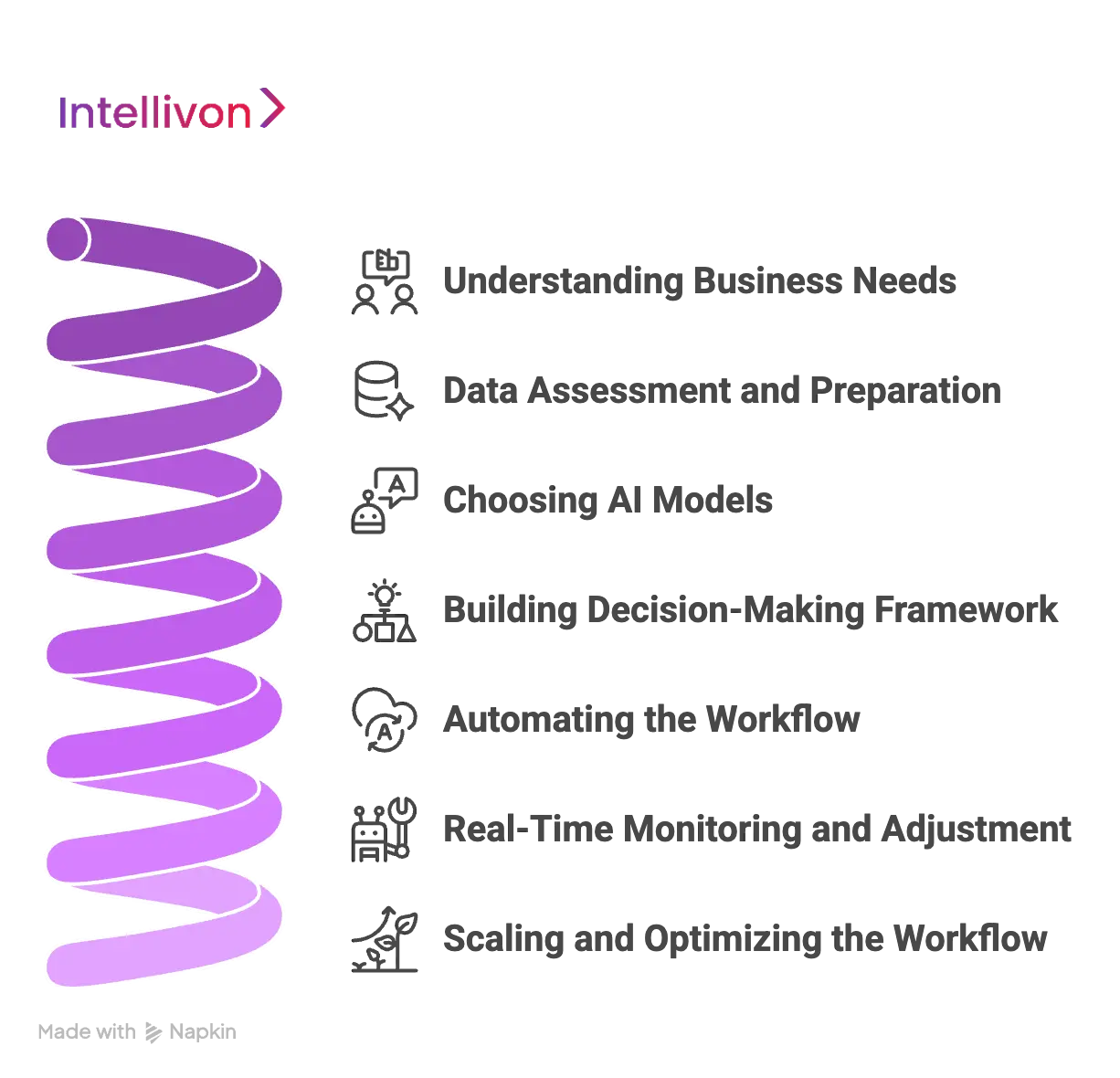
Step 1: Understanding Your Business Needs
Before diving into building AI workflows, the first step is to understand your business. We start by having in-depth conversations with your team to uncover your goals, pain points, and the specific processes you want to automate or improve.
Defining Clear Objectives: We help you set clear, measurable goals for your AI project. Whether it’s reducing operational costs, speeding up decision-making, or improving customer satisfaction, these objectives will guide the AI design and implementation.
Understanding the problem at the start allows us to build workflows that are not just technical solutions but tools that make a real difference in your business.
Step 2: Data Assessment and Preparation
Data is the foundation of any AI system. Without quality data, even the most advanced AI models won’t work effectively. We take a comprehensive approach to assessing and preparing your data.
- Data Audit: We begin by evaluating your current data sources. This could be from CRM systems, ERP platforms, web analytics, or IoT devices. We check for consistency, quality, and completeness.
- Data Cleansing: Data often comes with inconsistencies, like duplicate entries, missing values, or errors. We “clean” the data to ensure it’s accurate and ready for use.
- Data Normalization: This process ensures that data from different sources is standardized, so it can be processed effectively by the AI models.
Once your data is clean and well-organized, we’ll integrate it into the AI system, ensuring it’s both accessible and usable for the AI to make informed decisions.
Step 3: Choosing the Right AI Models
AI models are the “brains” behind the decision-making process. Choosing the right model is crucial for achieving the desired outcomes. Depending on the goals of your workflow, we select the most suitable models that will drive success.
- Reinforcement Learning: For tasks where the AI learns through trial and error, like optimizing a delivery route or adjusting inventory levels.
- Deep Learning: For complex pattern recognition, such as detecting fraud from transaction data or identifying product defects from images.
- Supervised Learning: For situations where the AI is trained using labeled data, such as classifying customer inquiries based on urgency.
Each of these models has its strengths and is selected based on your unique needs. Our team of experts at Intellivon ensures that we use the most effective models for your business challenges.
Step 4: Building the Decision-Making Framework
The AI needs a framework for decision-making. This involves designing the decision logic that the AI will follow when it encounters a scenario. In this stage, we ensure that the AI can act autonomously while still aligning with your business objectives and policies.
- Context-Aware Decisions: The AI is not just making random decisions; it understands the context of its actions. For instance, if your customer service AI is handling inquiries, it understands whether the issue is urgent or requires specialized help.
- Real-Time Decision-Making: We build systems where the AI can analyze data and make decisions in real time. For example, if a supply chain system detects a delay, the AI might automatically reroute shipments to minimize disruption.
We also incorporate explainability into the decision-making models. This means that humans can understand how the AI arrived at a specific decision, which is important for auditing and maintaining trust.
Step 5: Automating the Workflow
Once the AI has the ability to make decisions, it’s time to build the automation layer. This involves creating workflows that allow the AI to act on its decisions without manual intervention.
- End-to-End Automation: Instead of automating just one task, we focus on automating the entire process. For example, in customer service, the AI can handle everything from understanding the customer’s issue to providing a resolution or escalating the case to a human expert if necessary.
- Seamless Integration: The AI doesn’t exist in a vacuum. It needs to work smoothly with your existing systems, whether that’s your CRM, ERP, or other business tools. We ensure the AI integrates seamlessly with these systems so that it can execute tasks in real time.
Automation leads to improved speed, accuracy, and efficiency. Your business will operate faster and with fewer human errors.
Step 6: Real-Time Monitoring and Adjustment
Even the most intelligent AI systems need oversight. After deploying the AI workflows, we continue to monitor and fine-tune them to ensure they perform optimally.
- AI Monitoring Tools: We provide real-time dashboards that give you visibility into how the AI is making decisions and executing tasks. You can see the decisions it’s making, the data it’s using, and intervene if necessary.
- Continuous Improvement: AI isn’t set-and-forget. It learns and evolves over time, but it still needs periodic adjustments. We make sure that the AI workflow continues to improve by regularly reviewing its performance and applying updates as needed.
At Intellivon, we ensure that the AI workflows we build are not only effective but also maintainable in the long term.
Step 7: Scaling and Optimizing the Workflow
As your business grows, so do your needs. Agentic AI workflows should be scalable to handle an increase in data or a rise in demand.
- Scalability: The AI systems we build are designed to scale seamlessly. Whether you’re handling more customer inquiries, processing more transactions, or managing additional products, the AI can grow with you.
- Optimization: As the AI learns from its actions and your business evolves, we optimize the workflows to ensure they remain efficient. We continuously improve the system, adjusting to new business goals or external changes (like market shifts or technology upgrades).
By ensuring your AI workflows can scale and optimize, we help future-proof your business, making sure you’re always prepared for what’s next.
At Intellivon, our step-by-step approach ensures that we build agentic AI workflows that are not just technically sophisticated but also aligned with your business objectives. From understanding your goals to scaling and optimizing, we make sure that AI becomes a powerful, integral part of your operations. With our expertise and tailored solutions, you can leverage AI to increase efficiency, enhance decision-making, and drive real business growth.
Key Technologies That Power Our Agentic AI Workflows
Agentic AI workflows are powered by a range of sophisticated technologies, each carefully chosen to ensure the AI is fast, effective, and adaptable. While the technology behind these workflows is complex, the goal is simple: to create intelligent systems that automate processes, make decisions, and learn over time. Here’s an overview of the key technologies that power our agentic AI workflows:
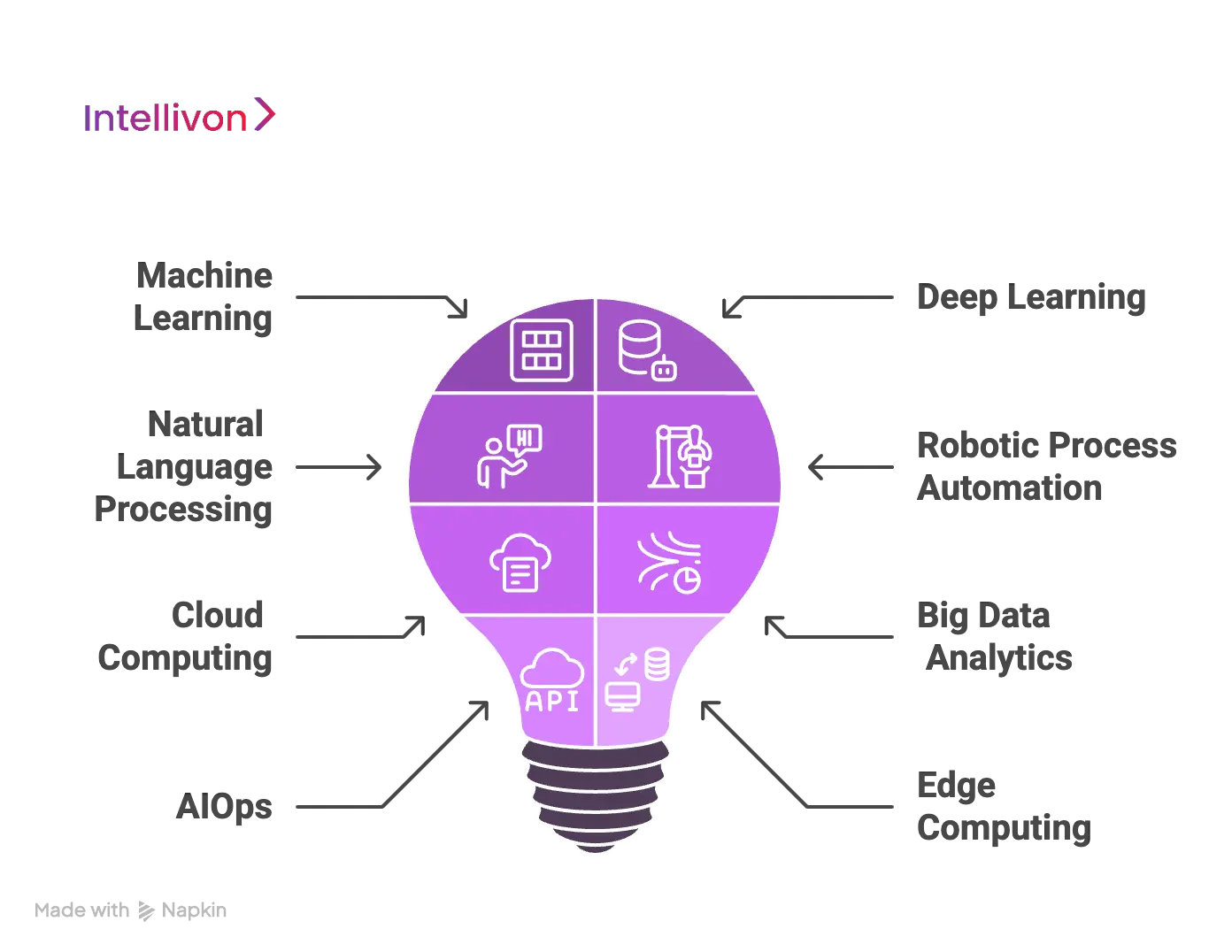
1. Machine Learning (ML)
At the core of agentic AI is machine learning (ML), which enables the system to learn from data and improve its performance without explicit programming.
- What It Does: ML allows the AI to recognize patterns, make predictions, and continuously improve over time by learning from new data. For example, an AI model could learn how customers interact with your website, then predict the next best action to take to engage them.
- Why It’s Important: ML is what makes AI truly intelligent. It allows the system to make decisions based on experience, not just fixed rules. This is essential for creating dynamic, adaptive workflows that evolve as your business needs change.
2. Deep Learning
Deep learning is a specialized branch of machine learning that uses neural networks to process data in ways that mimic how the human brain works. It’s especially powerful when it comes to handling large amounts of complex data.
- What It Does: Deep learning excels at tasks like image recognition, natural language processing, and speech recognition. It can analyze large datasets, identify patterns, and make predictions or decisions based on that data.
- Why It’s Important: For tasks such as fraud detection, image-based quality control, or analyzing unstructured data (like customer reviews), deep learning enables the AI to go beyond simple tasks and tackle more complex challenges. This makes workflows smarter and more efficient.
3. Natural Language Processing (NLP)
Natural Language Processing (NLP) is a key technology that allows AI to understand and process human language, whether it’s text or speech.
- What It Does: NLP enables the AI to read, interpret, and respond to human language. In a customer service setting, for example, NLP allows the AI to understand customer inquiries, analyze the intent behind them, and generate appropriate responses.
- Why It’s Important: As businesses increasingly interact with customers through text (emails, chatbots, social media), NLP is essential for enabling AI workflows to handle these interactions automatically and intelligently. This leads to faster responses, improved customer satisfaction, and a more efficient process.
4. Robotic Process Automation (RPA)
Robotic Process Automation (RPA) allows AI to automate repetitive, rule-based tasks that would otherwise require human effort. While not technically “intelligent” on its own, RPA is crucial for automating workflows alongside AI.
- What It Does: RPA can handle tasks like data entry, transaction processing, and reporting. For example, if an AI detects an issue with an order, RPA can automatically update the order status or generate a report without needing human input.
- Why It’s Important: When combined with AI, RPA speeds up workflows and frees up human workers to focus on more complex tasks. It’s essential for automating back-office operations, improving efficiency, and reducing errors.
5. Cloud Computing
Cloud computing provides the infrastructure and resources that allow agentic AI systems to operate efficiently, securely, and at scale.
- What It Does: The cloud allows AI systems to store and process large amounts of data without the need for expensive on-site hardware. Cloud platforms like AWS, Microsoft Azure, and Google Cloud provide scalable storage, computing power, and security for AI applications.
- Why It’s Important: Cloud computing ensures that AI workflows can operate in real time, no matter the volume of data or complexity of the tasks. It also ensures your AI systems can scale as your business grows, with flexible and cost-effective infrastructure.
6. Big Data Analytics
Big data analytics refers to the technology used to analyze massive datasets and extract useful insights from them. With agentic AI workflows, this technology helps the system make better, data-driven decisions.
- What It Does: Big data tools process large volumes of structured and unstructured data quickly and accurately. This can include customer behavior data, sales trends, market data, or operational performance metrics.
- Why It’s Important: Agentic AI needs to analyze vast amounts of data from various sources to make real-time decisions. Big data analytics ensures that the AI can process all this information quickly and efficiently, allowing for smarter decision-making and automation across the business.
7. AIOps for Workflow Optimization
AIOps, or Artificial Intelligence for IT Operations, is a critical technology that ensures the smooth operation of your entire AI-powered ecosystem.
- Predictive Problem-Solving: AIOps tools continuously monitor your IT infrastructure using machine learning. They predict potential issues before they occur. For example, the system might notice patterns indicating an impending system failure and trigger a fix automatically, preventing downtime before it impacts operations.
- Automated Incident Response: If an issue does arise, AIOps tools can autonomously diagnose the root cause and even initiate automated remediation. This significantly reduces downtime and eliminates the need for human intervention. AIOps allows your system to self-heal, ensuring continuous operation of your AI workflows without disruption.
8. Edge Computing
Edge computing moves computing power closer to where the data is generated (i.e., at the “edge” of the network), rather than relying on centralized data centers.
- What It Does: In an agentic AI system, edge computing allows the AI to process data locally, reducing latency and improving real-time decision-making. For example, an AI-powered manufacturing system can monitor equipment performance and make adjustments instantly, without waiting for cloud processing.
- Why It’s Important: For time-sensitive operations, edge computing ensures that decisions are made in real-time, without delays. This is especially important in industries like manufacturing, transportation, and healthcare, where speed and precision are critical.
These technologies come together to create AI workflows that are not only intelligent but also capable of making decisions in real time, learning from experience, and adapting to changing conditions. By combining machine learning, deep learning, NLP, and other tools, agentic AI can handle complex tasks with remarkable efficiency and accuracy.
Common Implementation Challenges and Our Solution
While agentic AI workflows offer powerful benefits, their implementation can come with challenges. We’ve worked with many businesses to overcome these obstacles and successfully integrate AI into their operations. Here are some of the most common challenges enterprises face when implementing agentic AI workflows, and how we solve them.
1. Data Quality and Integration Issues
Challenge: For AI workflows to work effectively, they need a constant flow of clean, high-quality data. However, many businesses struggle with data silos, inconsistent data formats, and poor-quality data. This can make it difficult for the AI to make accurate decisions.
Our Solution: We start by conducting a thorough data audit. We help businesses identify where their data lives (CRM, ERP, spreadsheets, etc.), assess its quality, and clean it up. We then use powerful tools to integrate data from various sources and make it usable for AI. By ensuring the data is consistent, clean, and relevant, we lay the foundation for smooth AI workflow implementation.
2. Resistance to Change from Employees
Challenge: Many employees feel threatened by AI and fear that automation will replace their jobs. This can lead to resistance during the implementation of AI workflows, making it difficult to gain buy-in across the organization.
Our Solution: We focus on human-AI collaboration rather than replacement. We work closely with your team to show how AI will enhance their work, not replace it. AI can handle repetitive, time-consuming tasks, freeing employees to focus on more strategic, creative, and high-value activities. We also offer training and support to help employees understand how to work with AI, so they feel confident and empowered.
3. Lack of Clear Business Objectives
Challenge: Without a clear understanding of what the business wants to achieve, AI workflows can become disjointed or fail to deliver the expected outcomes. Often, enterprises jump into AI without a clear strategy or measurable goals.
Our Solution: We start by working with your leadership team to define clear, measurable business objectives. Whether it’s reducing operational costs, improving customer service, or speeding up decision-making, we ensure the AI workflow is designed to achieve these goals. We use this clarity to guide the AI design, ensuring that every aspect of the workflow is aligned with your business needs.
4. Integration with Existing Systems
Challenge: Integrating agentic AI workflows with existing systems like CRM, ERP, or other enterprise tools can be complex. Many businesses worry about how AI will interact with their current infrastructure, which may be outdated or fragmented.
Our Solution: We take a modular approach to integration. We ensure that AI workflows seamlessly connect with your existing systems without disrupting operations. We also prioritize flexibility by using cloud-based platforms and API integrations, which allow us to connect AI to your existing infrastructure without requiring significant changes to your current systems.
5. Ensuring Ethical AI
Challenge: As AI becomes more autonomous, businesses are concerned about transparency and ethics. They want to ensure that the AI’s decisions are fair, unbiased, and aligned with company values.
Our Solution: We build AI models that are explainable and auditable. This means that every decision the AI makes is understandable and can be traced back to the data it used.
We also incorporate ethical guardrails to prevent bias and ensure fairness in the AI’s decision-making. This transparency helps businesses maintain trust with their customers and ensures that the AI aligns with the company’s values and policies.
6. Scaling AI Workflows
Challenge: As businesses grow, they often face difficulties in scaling their AI workflows. What works for a small project might not work when expanded across the entire organization.
Our Solution: We design scalable AI workflows from the start. Using cloud-based solutions, we ensure that your AI system can grow with your business, handling larger datasets, more tasks, and higher demands without additional complexity. Whether you’re expanding to new regions, increasing your customer base, or launching new products, our workflows are built to scale smoothly and efficiently.
Implementing agentic AI workflows can be challenging, but the benefits far outweigh the obstacles. We help enterprises overcome these challenges with a strategic, thoughtful approach that ensures smooth implementation and long-term success. From data integration to employee training and scalable solutions, we make sure your AI workflows are not only effective but also aligned with your business goals.
Future of Agentic AI in Enterprises
The future of agentic AI goes beyond just automating tasks. It’s about fundamentally changing how businesses operate. We’re entering an era where AI agents work together as a cohesive system, driving companies forward. Here’s a look at the key trends shaping the future of agentic AI in enterprises:
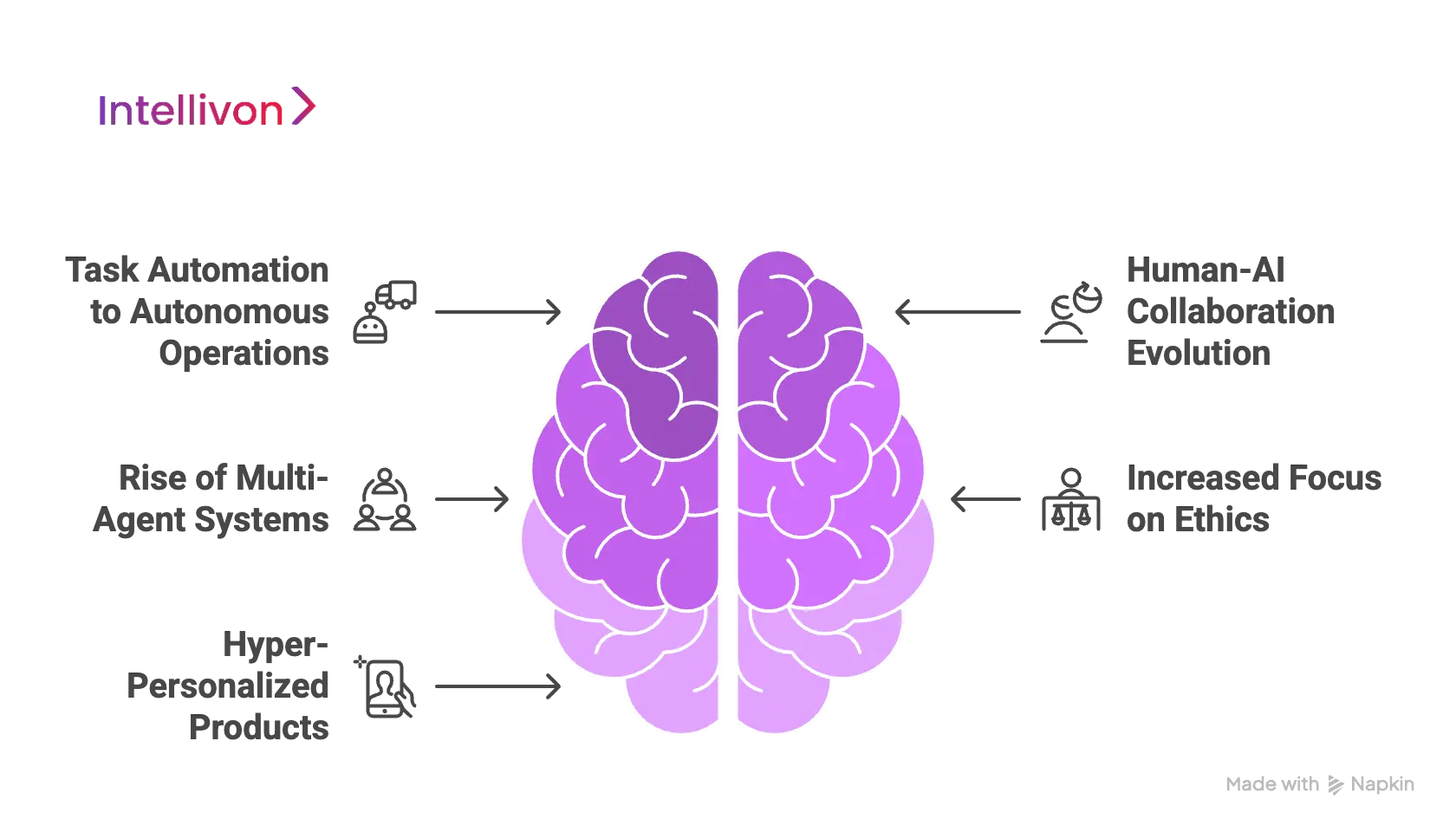
1. From Task Automation to Autonomous Operations
Agentic AI will evolve from handling simple, repetitive tasks to managing complex, end-to-end workflows. Instead of just automating an individual task, like sending an email, AI will take on entire projects. For example, a marketing AI could manage everything from content creation to audience targeting and performance analysis.
This shift will create a cognitive enterprise, an organization that continuously learns and improves its operations. As AI becomes more intelligent, it will drive autonomous operations, enabling businesses to run with minimal manual intervention.
2. Human-AI Collaboration Evolution
The role of humans in businesses will shift from being task executors to AI managers and strategists. Instead of doing the operational work, employees will focus on high-value activities that require creativity, empathy, and critical thinking.
For example, human employees will set strategic goals, monitor AI performance, and intervene only when necessary. This new type of collaboration will foster a more powerful partnership between human intelligence and artificial intelligence, boosting productivity and innovation.
3. The Rise of Multi-Agent Systems
In the future, enterprises will use not just one AI agent but a network of specialized agents working together. These agents will each handle different tasks and collaborate to provide more complex and robust solutions.
For example, a customer service agent might work alongside a billing agent and a technical support agent to resolve a customer issue seamlessly. The ability of multiple AI agents to collaborate will create more intelligent, efficient workflows that handle a wider range of tasks in parallel.
4. Increased Focus on Ethics
As AI agents become more autonomous, the need for strong ethics and governance frameworks will grow. Businesses will need to ensure that their AI systems are transparent, fair, and accountable in their decision-making.
There will be an increasing focus on preventing bias in AI, monitoring AI decisions, and making sure that these systems align with the company’s values. Businesses will also need to be more transparent with employees and customers about how AI is making decisions. This focus on governance will help build trust and ensure that AI agents act in ways that are ethical and aligned with corporate goals.
5. Hyper-Personalized Products
Agentic AI won’t just improve existing workflows; it will also enable new business models. Businesses will be able to offer highly personalized products and services at a scale that was once impossible. For example, an AI-driven company could deliver customized experiences to thousands of customers without extra human effort, creating new revenue streams and competitive advantages.
This will allow businesses to offer more tailored solutions to customers, driving growth and creating entirely new ways of operating in the market. Forward-thinking enterprises will embrace these opportunities, using AI to redefine their business strategies.
The future of agentic AI is exciting. It will transform businesses by automating complex workflows, enabling deeper human-AI collaboration, and introducing new business models. With a focus on ethics and governance, businesses will be able to leverage AI to drive efficiency, improve decision-making, and stay ahead of the competition.
Conclusion
Agentic AI workflows offer transformative benefits for businesses, driving efficiency, scalability, and data-driven decision-making. By automating complex processes and enabling real-time, intelligent decisions, agentic AI empowers companies to streamline operations and adapt quickly to changing demands. Its ability to learn from data and continuously improve ensures that workflows remain optimized, reducing errors and enhancing performance.
As enterprises face increasing complexity, agentic AI provides a powerful solution to stay ahead of the competition, maximize resources, and make smarter, more informed decisions that drive growth and innovation.
Build Agentic AI Workflows for Your Enterprise with Intellivon
With years of expertise in AI-driven solutions and numerous successful deployments across industries, we are your trusted partner in creating secure, scalable, and intelligent agentic AI workflows. We don’t just implement basic automation; we design tailored workflows that evolve with your business, optimizing performance and driving efficiency.
What Sets Us Apart?
- Tailored AI Solutions: We design workflows specifically for your enterprise, ensuring they align with your business goals and industry needs.
- Seamless Integration: Our solutions integrate effortlessly with your existing systems (CRM, ERP, and more), enhancing overall efficiency without disrupting your operations.
- Enterprise-Grade Security: We prioritize your data security with end-to-end encryption and ensure compliance with industry standards, including GDPR and HIPAA.
- Scalability and Flexibility: Whether you’re scaling up operations or expanding globally, our workflows grow with your business, adapting to new challenges.
- Continuous Optimization: We monitor, optimize, and refine them continuously, ensuring peak performance and long-term success.
Our Expert Team Will Provide:
- A comprehensive analysis of your AI strategy and business goals
- Customized use cases to maximize your enterprise’s ROI
- A clear deployment roadmap tailored to your business and tech stack
- Scalable and secure AI architecture to support your growth
- Ongoing performance monitoring and updates to optimize results
Book your free strategy call today and start building agentic AI workflows that will transform your operations, enhance decision-making, and unlock growth for the future.
FAQ’s
1. What is Agentic AI, and how does it work in business workflows?
Agentic AI refers to autonomous systems that can make decisions and take actions based on real-time data without human intervention. It works by collecting data, understanding context, making decisions, executing tasks, and continuously learning from its actions. This makes it ideal for automating complex workflows, improving efficiency, and enabling data-driven decision-making in businesses.
2. How can Agentic AI improve business efficiency?
Agentic AI automates complex workflows, reducing the need for manual interventions. It speeds up decision-making, optimizes processes, and handles tasks like fraud detection, customer service, and supply chain management. This leads to faster operations, reduced errors, and the ability to scale with minimal resources, ultimately driving business efficiency.
3. What are the key benefits of using Agentic AI for enterprises?
The main benefits of agentic AI for enterprises include enhanced efficiency, scalability, and data-driven decision-making. It can automate routine tasks, predict trends, make real-time decisions, and continuously learn from new data, enabling businesses to improve operations, reduce costs, and make smarter decisions.
4. How does Agentic AI ensure data security in enterprise workflows?
Agentic AI ensures data security through end-to-end encryption, compliance with industry standards like GDPR and HIPAA, and robust data governance policies. These safeguards protect sensitive information and ensure that AI workflows operate within legal and regulatory frameworks while maintaining high security.
5. Can Agentic AI workflows scale as my business grows?
Yes, agentic AI workflows are designed to scale with your business. They leverage cloud computing and flexible infrastructure to handle increased data volumes, more complex tasks, and expanding operations. Whether you’re scaling locally or globally, agentic AI ensures your workflows adapt to meet growing demands without compromising performance.

